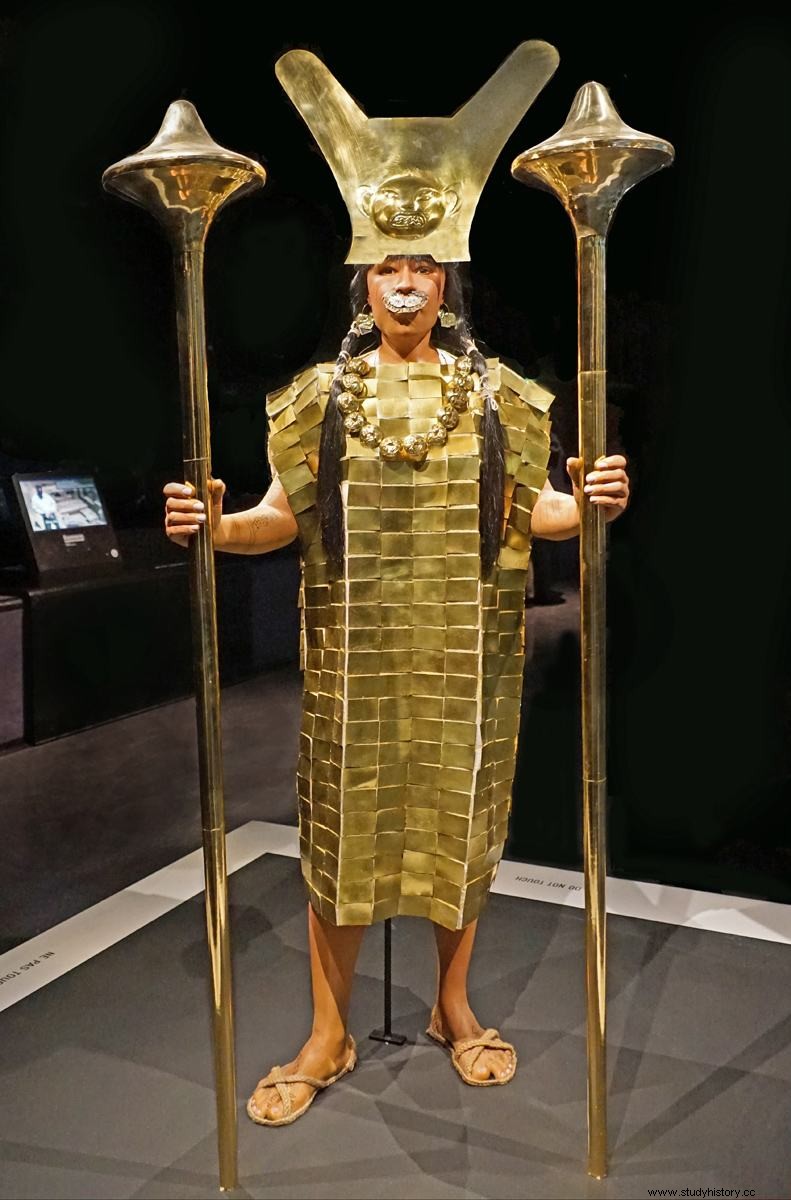Woman of the pre-Columbian Moche culture, the "Lady of Cao", whose name is not known, lived in the 5 th century and probably played an important political or even religious role. Her discovery challenged the assumptions then in force on the place of women in the Moche culture.
Moche Culture

A pre-Columbian civilization dating from around 100 to 700, the Moche (or Mochica) civilization stretched, at its height, over nearly 500 kilometers of coastal Peru, from the Huarmey Valley in the south to the Piura Valley. A powerful people, the Moches build large, carefully organized cities, earthen brick palaces and stepped pyramid temples.
The Moches are organized into a hierarchical society with a political leader, perhaps also a religious leader, at the head of castes:warriors, priests and administrators in the first place, then craftsmen (weavers, ceramists, metallurgists, etc.) and builders and finally farmers and fishermen. The city of Moche, an important center of Moche culture located on the northern coast of Peru, is thus organized by neighborhoods corresponding to the castes, the importance of which determines the distance to the central administrative building.
The Moches do not use the wheel and have neither money nor writing, but have ingenious and sophisticated techniques, particularly in the fields of irrigation and metallurgy. They thus work copper, silver, bronze, to make jewelry, weapons and agricultural tools, and use irrigation efficiently to grow corn, beans and squash. They also develop, on the walls of buildings, ceramics or clothing, an abundant visual culture representing their society, their environment or their mythology.
Religion is an important aspect of Moche life, and the ruler and priests perform many ceremonies at the temple, the huaca de la Luna – a name originating from the Spanish settlers and not from the Moches who left no written records . Worshiping the god Ai-apaec in particular, the Moches carry out human sacrifices, as evidenced by certain frescoes and ceramics, but also human bones found at the top of the huaca.
Religious power or political power, the commonly accepted hypothesis is then that of male power. In 2006, the discovery of the tomb of the Lady of Cao upset certainties.
A woman of power

In 2006, a team of Peruvian archaeologists discovered a burial chamber within the Huaca Cao Viejo, an administrative and ceremonial center of the archaeological site of El Brujo (the sorcerer), on the northern coast of Peru. The tomb houses the mummy of a 1.45 meter tall, 20-25 year old female, as well as the remains of an apparently sacrificed young girl. Buried around 450, the woman bears the traces of a pregnancy and childbirth which could have led to her death. Above all, the "Lady of Cao", whose name we will never know, is surrounded by political, military and religious symbols.

Buried in many layers of fabric, the Lady of Cao is found covered with 18 rich necklaces of gold, silver, lapis lazuli, quartz and turquoise, as well as gold and silver nose ornaments and of gilded copper crowns. In addition to jewels, archaeologists also discovered in the tomb symbols of political power, such as scepters, and weapons. Her body is covered with tattoos of snakes, spiders, geometric shapes. These tattoos, as well as certain ceramics found in the tomb and depicting scenes of healing, suggest that the Lady of Cao officiated as a healer.
The discovery of this mummy, presumably of a leader of a pre-Columbian civilization, shakes up assumptions about the status of women at the time; it proves that women could then exercise political, military and religious power. Since its discovery, other tombs have revealed the mummies of women surrounded by objects showing their high political and religious functions.
In 2017, a team of scientists worked for ten months to digitally recreate the face of the Lady of Cao, from the structure of her skull. On the occasion of the inauguration of the exhibition, the Peruvian Minister of Culture Salvador del Solar said of this sovereign of the Moche civilization:"The discovery of the Lady of Cao had highlighted the power of women in this rich culture”.
Useful links
Lady of Cao's English Wikipedia page
Peru reveals face of ancient young female ruler Lady of Cao
The lousy culture
